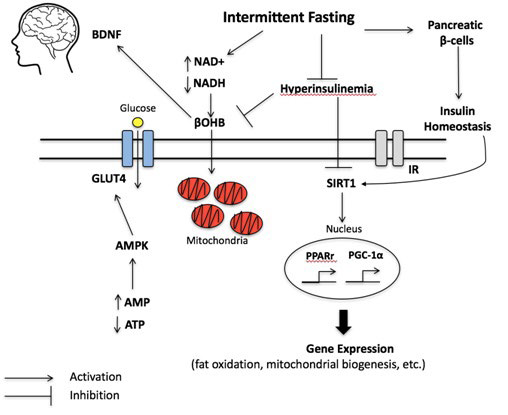1. Flegal KM, Carroll MD, Ogden CL, Curtin LR. Prevalence and trends in obesity among US adults, 1999-2008. JAMA. 2010; 303(3): 235-241. doi: 10.1001/jama.2009.2014
2. Wright SM, Aronne LJ. Causes of obesity. Abdominal Imaging. 2012; 37(5): 730-732. doi: 10.1007/s00261-012-9862-x
3. Charles J, Pollack A, Britt H. Type 2 diabetes and obesity in young adults. Aust Fam Physician, 2015; 44(5): 269-270.
4. Whitmore C. Type 2 diabetes and obesity in adults. Br J Nurs. 2010; 19(4): 880-886. doi: 10.12968/bjon.2010.19.14.49041
5. Donath MY, Shoelson SE. Type 2 diabetes as an inflammatory disease. Nat Rev Immunol. 2011; 11(2): 98-107. doi: 10.1038/nri2925
6. Giugliano D, Ceriello A, Esposito K. Glucose metabolism and hyperglycemia. Am J Clin Nutr. 2008; 87(1): 217S-222S. doi: 10.1093/ajcn/87.1.217S
7. Barnosky AR, Hoddy KK, Unterman TG, Varady KA. Intermittent fasting vs daily calorie restriction for type 2 diabetes prevention: A review of human findings. Transl Res. 2014; 164(4): 302-311. doi: 10.1016/j.trsl.2014.05.013
8. Moro T, Tinsley G, Bianco A, et al. Effects of eight weeks of time-restricted feeding (16/8) on basal metabolism, maximal strength, body composition, inflammation, and cardiovascular risk factors in resistance-trained males. Journal of Translational Medicine. 2016; 14(1). doi: 10.1186/s12967-016-1044-0
9. Mattson MP, Longo VD, Harvie M. Impact of intermittent fasting on health and disease processes. Ageing Res Rev. 2017; 39: 46-58. doi: 10.1016/j.arr.2016.10.005
10. Baumeier C, Kaiser D, Heeren J, et al. Caloric restriction and intermittent fasting alter hepatic lipid droplet proteome and diacylglycerol species and prevent diabetes in NZO mice. Biochim Biophys Acta, 2015; 1851(5): 566-576. doi: 10.1016/j.bbalip.2015.01.013
11. Eshghinia S, Mohammadzadeh F. The effects of modified alternate-day fasting diet on weight loss and CAD risk factors in overweight and obese women. J Diabetes Metab Disord. 2013; 12(1): 4. doi: 10.1186/2251-6581-12-4
12. Johnson JB, Summer W, Cutler RG, et al. Alternate day calorie restriction improves clinical findings and reduces markers of oxidative stress and inflammation in overweight adults with moderate asthma. Free Radic Biol Med. 2007; 42(5): 665-674. doi: 10.1016/j freeradbiomed.2006.12.005
13. Varady KA, Bhutani S, Church EC, Klempel MC. Short-term modified alternate-day fasting: A novel dietary strategy for weight loss and cardioprotection in obese adults. Am J Clin Nutr. 2009; 90(5): 1138-1143. doi: 10.3945/ajcn.2009.28380
14. Klempel, MC, Kroeger CM, Bhutani S, et al. Intermittent fasting combined with calorie restriction is effective for weight loss and cardio-protection in obese women. Nutr J. 2012; 11: 98. doi: 10.1186/1475-2891-11-98
15. Li X. SIRT1 and energy metabolism. Acta Biochim Biophys Sin (Shanghai). 2013; 45(1): 51-60. doi: 10.1093/abbs/gms108
16. Zhu Y, Yan Y, Gius DR, Vassilopoulos A. Metabolic regulation of Sirtuins upon fasting and the implication for cancer. Curr Opin Oncol. 2013; 25(6): 630-636. doi: 10.1097/01.cco.0000432527.49984. a3
17. Stefanowicz M, Nikołajuk A, Matulewicz N, Karczewskakupczewska M. Adipose tissue, but not skeletal muscle, sirtuin 1 expression is decreased in obesity and related to insulin sensitivity. Endocrine. 2018; 60(2): 263-271. doi: 10.1007/s12020-018-1544-1
18. Newman JC, Verdin E. β-hydroxybutyrate: Much more than a metabolite. Diabetes Res Clin Pract. 2014; 106(2): 173-181. doi: 10.1016/j.diabres.2014.08.009
19. Marosi K, Kim SW, Moehl K, et al. 3-Hydroxybutyrate regulates energy metabolism and induces BDNF expression in cerebral cortical neurons. J Neurochem. 2016; 139(5): 769-781. doi: 10.1111/ jnc.13868
20. Bastani A, Rajabi S, Kianimarkani F. The effects of fasting during ramadan on the concentration of serotonin, dopamine, brainderived neurotrophic factor and nerve growth factor. Neurol Int. 2017; 9(2): 7043. doi: 10.4081/ni.2017.7043
21. Fujinami A, Ohta K, Obayashi H, et al. Serum brain-derived neurotrophic factor in patients with type 2 diabetes mellitus: Relationship to glucose metabolism and biomarkers of insulin resistance. Clin Biochem. 2008; 41(10-11): 812-817. doi: 10.1016/j. clinbiochem.2008.03.003
22. Araki S, Yamamoto Y, Dobashi K, et al. Decreased plasma levels of brain-derived neurotrophic factor and its relationship with obesity and birth weight in obese Japanese children. Obes Res Clin Pract. 2014; 8(1): e63-e69. doi: 10.1016/j.orcp.2012.07.003
23. Eyileten C, Kaplon-cieslicka A, Mirowska-Guzel D, et al. Antidiabetic effect of brain-derived neurotrophic factor and its association with Inflammation in Type 2 Diabetes Mellitus. J Diabetes Res. 2017; 2017: doi: 10.1155/2017/2823671
24. Rothman SM, Griffioen KJ, Wan R, Mattson MP. Brain-derived neurotrophic factor as a regulator of systemic and brain energy metabolism and cardiovascular health. Ann N Y Acad Sci. 2012; 1264: 49-63. doi: 10.1111/j.1749-6632.2012.06525.x
25. Jornayvaz FR, Shulman GI. Regulation of mitochondrial biogenesis. Essays Biochem. 2010; 47: 69-84. doi: 10.1042/bse0470069
26. Hammarstedt A, Jansson PA, Wesslau C, et al. Reduced expression of PGC-1 and insulin-signaling molecules in adipose tissue is associated with insulin resistance. Biochem Biophys Res Commun. 2003; 301(2): 578-82. doi: 10.1016/S0006-291X(03)00014-
27. Park SK, Prolla TA. Lessons learned from gene expression profile studies of aging and caloric restriction. Ageing Res Rev. 2005; 4(1): 55-65. doi: 10.1016/j.arr.2004.09.003
28. Dohm GL. Invited review: Regulation of skeletal muscle GLUT-4 expression by exercise. J Appl Physiol. 2002; 93(2): 782-7. doi: 10.1152/japplphysiol.01266.2001
29. Dorighello GG, Rovani JC, Luhman CJ, et al. Food restriction by intermittent fasting induces diabetes and obesity and aggravates spontaneous atherosclerosis development in hyper cholesterolaemic mice. Br J Nutr. 2014; 111(6) :979-86. doi: 10.1017/ S0007114513003383






